Sirsa means the head. This is the head stand pose, one of the most important Yogic asanas. It is the basic posture. It has several variations, which are described later as the Sirsasana cycle. Its mastery gives one balance and poise, both physically and mentally. The technique of doing it is given at length in two parts; the first is for beginners, the second for those who can remain balanced in the pose.
Technique
1.Spread a blanket fourfold on the floor and kneel near it.
2.Rest the forearms on the centre of the blanket. While doing so take care that the distance between the elbows on the floor is not wider than the shoulders.
3.Interlock the fingers right up to the finger-tips , so that the palms form a cup. Place the sides of the palms near the little fingers on the blanket. While going up to your head or balancing, the finger should be kept tightly locked. If they are left loose, the weight of the body falls on them and the arms ache. So remember to lock them well.
4. Rest the crown of the head only on the blanket, so that the back of the head touches the palms which are cupped. Do not rest the forehead nor the back but only the crown of the head on the blanket. To do this move the knees towards the head.
5. After securing the head position, raise the knees from the floor by moving the toes closer to the head.
6.Exhale, take a gentle swing from the floor and lift the legs off the ground with bent knees. Take the swing in such a way that both feet leave the floor simultaneously. When once this position is secured, follow the various stages of the leg movements .
Stretch the legs and stand on the head, keeping the whole body perpendicular to the floor.
8. After staying in the final position to capacity, from one to five minutes, flex the knees and slide down to the floor in the reverse order.
Remember
- A beginner must have the assistance of a friend or do the asana against a wall. While practising against a wall, the distance between it and the head should not be more than 2 or 3 inches. If the distance is greater, the spine will curve and the stomach will protrude. The weight of the body will be felt on the elbows and the position of the head may change. The face will appear to be flushed and the eyes either strained or puffed. It is, therefore, advisable for a beginner to do the headstand in a corner where two walls meet, placing the head some 2 to 3 inches from either wall.
- While doing the head stand against a wall or in a corner, the beginner should exhale, swing the legs up, support the hips ag the side of the wall and move the feet up. In a corner, he can touch the heels to either side of the walls. He should then stretch the back vertically up, gradually leave the support of the wall and learn to do the asana.
Source : bks iyengar ( light on yoga)


